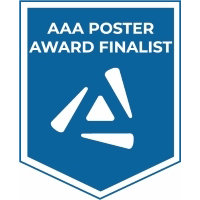Back
ANATOMY
Category: Anatomy
Session: 639 Bones, Cartilage & Teeth
(639.5) Cranial Dysmorphology in the Palatine, Vomer, and Pterygoid Plates of Fgfr2 mice
Monday, April 4, 2022
10:15 AM – 12:15 PM
Location: Exhibit/Poster Hall A-B - Pennsylvania Convention Center
Poster Board Number: C142
Introduction: AAA has separate poster presentation times for odd and even posters.
Odd poster #s – 10:15 am – 11:15 am
Even poster #s – 11:15 am – 12:15 pm
Introduction: AAA has separate poster presentation times for odd and even posters.
Odd poster #s – 10:15 am – 11:15 am
Even poster #s – 11:15 am – 12:15 pm
Amanda Pennings (University of Florida), Miette Ogg (University of Florida), Margaret McNulty (Indiana University School of Medicine), Megan Holmes (Duke University School of Medicine), Jason Mussell (Louisiana State University Health Science Center), Valerie DeLeon (University of Florida)
Amanda Pennings
Presenting Author
University of Florida
Presenting Author(s)
The fibroblast growth factor and receptor system (FGF/FGFR) regulates cell proliferation and differentiation for various tissue types in the body – including osseous tissue. Mutations in the FGFR2 gene are associated with craniosynostosis, leading to alterations of the shape of bones in the head and face. We have previously demonstrated premature fusion of the spheno-septal synchondrosis in Fgfr2C342Y/+ mice, a model for Crouzon syndrome. Here, we further describe the specific morphology of individual bones as a result of the Fgfr2C342Y/+ mutation.
We used microCT scans of mutant and wild-type littermates at two developmental stages (adult and postnatal day 14) to create 3D virtual reconstructions of the skull in the program 3DSlicer. After transforming each scan to a uniform, orthogonal orientation, we collected coordinate data for 38 fixed craniometric landmarks to estimate the shape of the cranium. We used the geomorph package in R to perform a Procrustes superimposition and principal components analysis (PCA). We used the resulting shape coordinates in a two-way Procrustes ANOVA to test the effects of Age and Genotype. In addition, we isolated key cranial elements (palatine, vomer, and pterygoid plates of the sphenoid) to compare between genotype groups at the P14 stage using a mesh-to-mesh comparison. This allowed us to test our expectation that fusion of the spheno-septal synchondrosis has a greater impact on the vomer than on the palatines or pterygoid plates.
Our morphometric analysis and two-way Procrustes ANOVA confirmed previous reports of statistically significant cranial shape differences between wild-type and Fgfr2 mutants at both timepoints. Vomer shape was significantly altered in the mutant P14 cranium when compared to other key cranial elements (palatine, and sphenoidal pterygoid plates), suggesting that fusion of the spheno-septal synchondrosis has a greater impact on the vomer compared to the other bones in the skull. Our mesh-to-mesh comparison showed that the vomer is both dorso-ventrally and rostro-caudally compressed in mutants relative to wild-type mice at this early stage. Additionally, the palato-sphenoid suture appears prematurely fused in the mutants.
This study provides insight into the skeletal phenotypic mechanisms that characterize diseases involving mutations of the FGFR2 gene, such as Crouzon syndrome. The dysmorphology of individual bones affect other osseous structures due to morphological integration within the skull. Elucidating the underlying mechanisms of the phenotypic expression of FGFR2 syndromes supports further translational research.
Funding was provided in part by NIH/NIDCR 1R03DE019816 and Louisiana Board of Regents LEQSF(2013-14)-ENH-TR-06.
We used microCT scans of mutant and wild-type littermates at two developmental stages (adult and postnatal day 14) to create 3D virtual reconstructions of the skull in the program 3DSlicer. After transforming each scan to a uniform, orthogonal orientation, we collected coordinate data for 38 fixed craniometric landmarks to estimate the shape of the cranium. We used the geomorph package in R to perform a Procrustes superimposition and principal components analysis (PCA). We used the resulting shape coordinates in a two-way Procrustes ANOVA to test the effects of Age and Genotype. In addition, we isolated key cranial elements (palatine, vomer, and pterygoid plates of the sphenoid) to compare between genotype groups at the P14 stage using a mesh-to-mesh comparison. This allowed us to test our expectation that fusion of the spheno-septal synchondrosis has a greater impact on the vomer than on the palatines or pterygoid plates.
Our morphometric analysis and two-way Procrustes ANOVA confirmed previous reports of statistically significant cranial shape differences between wild-type and Fgfr2 mutants at both timepoints. Vomer shape was significantly altered in the mutant P14 cranium when compared to other key cranial elements (palatine, and sphenoidal pterygoid plates), suggesting that fusion of the spheno-septal synchondrosis has a greater impact on the vomer compared to the other bones in the skull. Our mesh-to-mesh comparison showed that the vomer is both dorso-ventrally and rostro-caudally compressed in mutants relative to wild-type mice at this early stage. Additionally, the palato-sphenoid suture appears prematurely fused in the mutants.
This study provides insight into the skeletal phenotypic mechanisms that characterize diseases involving mutations of the FGFR2 gene, such as Crouzon syndrome. The dysmorphology of individual bones affect other osseous structures due to morphological integration within the skull. Elucidating the underlying mechanisms of the phenotypic expression of FGFR2 syndromes supports further translational research.
Funding was provided in part by NIH/NIDCR 1R03DE019816 and Louisiana Board of Regents LEQSF(2013-14)-ENH-TR-06.

